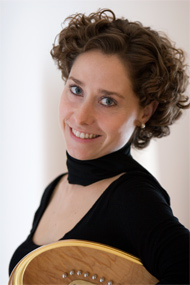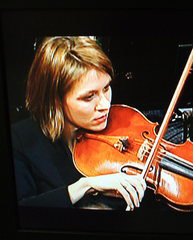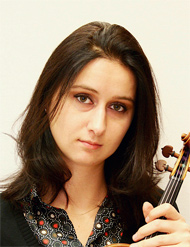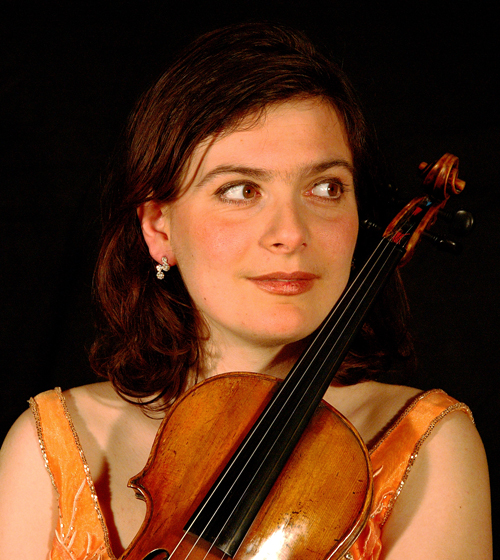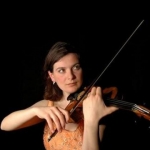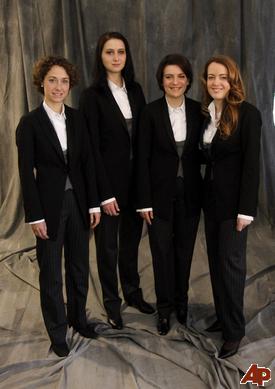|
Genteel Discretion and Easy Complacency ( the Vienna Philharmonic, December 2011)
By William Osborne December 31, 2011 In response to international protests and wide-spread, negative media coverage, the Vienna Philharmonic nominally ended its policy of excluding women in 1997. The orchestra allowed its harpist, Anna Lelkes, who had performed with them for 26 years in an associate position, to become an official member. Unfortunately, the changes stopped there. For the next ten years (1997-2006,) no further women were given membership, except for Ms. Lelkes’ replacement, the harpist Charlotte Balzereit.[1] By 2007, the Vienna Philharmonic once again faced protest and negative media because it had reneged on its promise to hire women. To counter these problems, the orchestra allowed five women to become members between 2007 and 2011. They are listed below, along with their instrument and year of membership[2]. Clicking on their pictures will lead to a website with more information about them.
Even with these additions, the Vienna Philharmonic still has the lowest ratio of women members in the world – 121 to 6.[3] And not surprisingly, during the 14 years since it agreed to admit women, it has hired them at a lower rate than any other orchestra. The
Glacier Stops Moving The Vienna Philharmonic also functions as the Vienna State Opera Orchestra. To enter the Philharmonic, musicians must first be hired by the Vienna State Opera and complete a tenure period which is usually about three years. Only one member of the Opera Orchestra has not been given membership in the Philharmonic after completing a tenure period, the cellist Ursula Wex, who was hired in 2003. For the last eight years, she has been denied membership in the Vienna Philharmonic because she took maternity leave while a member of the State Opera Orchestra. The Vienna State Opera Orchestra has not hired any new women members in the last four years, so aside from Ms.Wex whose situation is unlikely to change, there are currently no further women in the orchestra who can be tenured into the Philharmonic.[4] (Exceptions might exist if the Opera Orchesrtra has hired women with contracts beginning in this season, i.e. September 2011. The State Opera is often a few months behind in updating its website, which is what I use to monitor the new hires.) Even if a woman is hired in 2012, she will not be eligible for membership in the Philharmonic until at least 2015. This means that for at least the next three years, the rate of increase for women in the Vienna Philharmonic will be 0%. (And if any women have been engaged for the beginning of the current season, they would probably also not be tenured into the Philharmonic until 2015.) This also means that in the 18 years between 1997 and 2015, the Philharmonic will have given only six women membership, even though over half of the orchestra’s personnel will have been replaced during this period. The Vienna Philharmonic thus lags far behind international norms. Below is a table showing the total percentages of women in seven comparable major orchestras, and the increase in the membership of women during the four years from 2005 to 2009[5]:
Variations
In Rates and Ratios In major orchestras, musicians work on average about 30 years before retirement. In an average sized orchestra, this creates about a 4.3% yearly turnover for their personnel. (There is a variable margin of error in this number, since some musicians work longer than 30 years, and some leave sooner due to deaths or jobs such as professorships.) The Vienna Philharmonic averages about 130 members, so this comes to about 5.2 musicians per year that need to be hired as replacements for retirees. This allows us to reasonably estimate the m/f ratios for new hires in the Vienna Philharmonic as shown in the table below:
Even accounting for a large margin of error in the estimates for men hired, we see radical variations in the ratio of women among new hires during these three periods. After the Philharmonic agreed to admit women in 1997, the intense media scrutiny of the orchestra and the protests against it dropped off considerably. The Vienna Philharmonic was thus allowed to continue its discrimination and not hire any women aside from one woman harpist for the next ten years. In 2007, scrutiny of the Philharmonic increased after I published a widely read article documenting the continued exclusion of women, and combined it with a case study about the orchestra’s abuse and firing of a recently hired woman violinist. To counter the renewed controversy, the Philharmonic gave membership to five women in the next five years (2007-2011,) including a woman concertmaster. This raised the ratio of women among new hires during this five year period to about 19.23% -- which approaches international standards for major orchestras in the German-speaking world. It also raised the overall membership of women in the Vienna Philharmonic during this five year period by 0.78% per year which is slightly above the international standard of 0.71% per year.
We see a similar
pattern in the political activity against the orchestra in Biased
Auditions One reason the ratios for women remain low is that the audition process for the Vienna State Opera Orchestra can easily be biased toward specific individuals. The orchestra’s recent trombone audition provides a good example for documentation.[6] One of the
Philharmonic’s solo trombonists, Ian Bousfield, had agreed to adjudicate
audition CDs for a trombone competition hosted by the International Trombone
Association. He liked the playing
of one of the trombonists, Jeremy Wilson, who was a student at the Mr. Bousfield asked
Mr. Wilson to audition for the second trombone position that was open in the
orchestra. And most importantly,
he asked Mr. Wilson to come to Mr. Bousfield and
Mr. Stroecker also arranged for Mr. Wilson to be excused from the preliminary
round of the audition. As Mr.
Bousfield explained, “We
didn’t want to risk the possibility of losing him in the ‘cattle call’
preliminary.”[7] Mr. Wilson was
not only coached by two of the principal judges on how to win the audition, he
was also allowed to skip a round after one of the most important jurors openly
stated that he didn’t want him to lose.
The
preferential treatment given to Mr. Wilson by two members of the trombone
section is especially problematic, because in the Vienna Philharmonic (and
most all orchestras,) the audition juries often defer to the evaluations and
expertise of the jury members who play the instrument under consideration. For
the sake of fairness, if one candidate is given special coaching by members of
the jury in the week before the audition, the other candidates should be
offered the same advantage. In
this case, preferential treatment that biases auditions was given to a man
competing against other men, but it is also used by the Vienna Philharmonic to
tilt the playing field against women and racial minorities auditioning for the
orchestra. As
with many issues involving the Vienna Philharmonic, the circumstances
surrounding this trombone audition are complex and difficult to simply
categorize. The favored treatment
of one candidate represents serious ethical problems, but by favoring a
foreigner, Mr. Bousfield and Mr. Stroecker stepped outside the narrow
ethnocentricity that has damaged the reputation of the orchestra.
Since the Second World War, the low brass section (trombones and tubas)
has employed a higher ratio of foreigners than any other group in the Vienna
Philharmonic. The principle reason
is that the low brass traditions in The
relatively cosmopolitan perspectives of Mr. Bousfield and Mr. Stroecker also
explain why they were largely responsible for the Vienna State Opera Orchestra
hiring its first Asian member, the tubist Yasuhito Sugiyama.[8]
His employment contributed to acrimonious divisions within the low
brass section that remain to this day. Not
surprisingly, Mr. Sugiyama did not pass his trial year in the Vienna State
Opera Orchestra. After leaving, he
quickly won an audition for the Cleveland Symphony Orchestra, which indicates
that quality was probably not central to his departure from Vienna
. Genteel
Discretion and Moral Myopia The Among institutions
of higher learning, the School
of Fortunately, the San Francisco Chronicle published an article by Joshua Kosman that criticized the orchestra’s chauvinism entitled “Vienna Philharmonic Must Answer for Exclusion.”[13] Mr. Kosman examined the orchestra’s racial policies, even though the topic is still relatively taboo in the mainstream media. He described the Philharmonic’s long tradition of stylistic homogeneity, and explains that the orchestra has traditionally correlated this with gender and racial uniformity. He also mentions that the orchestra’s racism has been even more resistant to change than its sexism. He then comments on the ease with which the orchestra’s American agents, presenters, and fans have accepted its practices for decades:
“But at the very least, I'd expect
that the proponents of the VPO's policies should be compelled to defend them -
frequently, vigorously and consistently. Surely the default position in
To
explain the “easy complacency” with which Americans accept the
Philharmonic’s racism and sexism, Mr. Kosman considered the seemingly
inexplicable immunity classical music seems to have against ethical and moral
considerations: “But
all too
often, the matter has been greeted with a collective shrug, and the opposition
met in turn with hostility. The prevailing attitude seems to be that issues of
politics and morality - the sort of issues that most people can perceive
clearly in connection with, say, corporate glass ceilings or the patronage of
lunch counters - are suddenly off limits where music is concerned.” Mr.
Kosman goes on to suggest that this moral complacency is harmful to classical
music, because it creates a social exemption that reduces art’s capacity for
human engagement: “There is something unsettling and sad about this sort of glib aestheticism - the view that anything can be justified in the name of art - because the truth is precisely the opposite. To exempt music, and art in general, from moral considerations is not to protect it at all, but to marginalize it and rob it of any ability to engage on a human level.”
To add even more color to the ironies of the situation, after Mr. Kosman’s article appeared, the Vienna Philharmonic was quickly embraced by the New Century Foundation -- a large, well-known, white separatist organization.[14] The New Century Foundation printed excerpts from Mr. Kosman’s article on the website of their magazine, American Renaissance, where a large number of readers voiced their support for the Vienna Philharmonic’s employment practices – and often in racist terms.[15] There were also vehement denunciations of Mr. Kosman’s person. (The magazine has removed the comments, but I can provide a copy of them to those interested. Two representative examples are included in endnote 15.) During
the same tour, the University
of
The social and psychological
mechanisms that create these complex ironies in classical music remain almost
completely undefined and unexamined. It is probable that most of the faculty
members in the UCSB music department are strongly liberal, and that all of
them abhor racism and anti-Asian attitudes.
And yet the genteel discretion of the classical music world described
by Mr. Kosman and others[18] makes it acceptable for the department’s
cultured, white faculty to invite and
celebrate members of an orchestra widely known for its sexist and racist
employment practices. (See here
and here.) In
September 2010, the Vienna Philharmonic also performed at Centre College
in Danville, “When
you give a student an opportunity to be around greatness then they can imagine
that they too might be able to do great things. The most important impact is
that our people from
Here too, ironies abound. One might add that when you give students the “opportunity” to be around egregious sexism and racism, they too might think that is something to emulate. And he seems to be telling the students that “anything is possible,” except treating women and minorities equally.
Maintaining An “Authentic” Image
We thus see that even small changes have been slow and difficult for the Vienna Philharmonic. The most progress has come when the orchestra is under pressure from activists, politicians, and the press. When these vicissitudes ease, movement comes to a standstill. One can also observe that the sexism and racism of the Vienna Philharmonic is overlooked with “easy complacency” by its agents, funders, presenters, and public. It is also clear that the political establishment in Austria is only sporadically engaged with the Philharmonic’s chauvinism, and generally makes significant efforts to remedy the situation only when the orchestra is facing international scrutiny. And we see that the cultured, white, intellectuals of American musical academia all too often embody a genteel, moral myopia that not only allows them to ignore egregious sexism and racism in classical music, but even join in celebrating its worst proponents. With six women now in the Vienna Philharmonic, victory has clearly fallen into the hands of women, but work against tokenism and indifference will need to continue.
Updates: January 9, 2011. I've seen reports that the Vienna State Opera Orchestra has hired a second woman harpist, Anneleen Lenaerts, who began work at the beginning of this season. Her name is still not listed on the orchestra's website, so I'm awaiting further confirmation and will post the results here. This does not significantly change the situation I describe above. She will have to complete a three year tenure before she can apply for membership in the Philharmonic. She will thus not enter the orchestra until late 2014 at the earliest, and most likely in early 2015. From 1997 to 2006, only one woman entered the Philharmonic, harpist Charlotte Balzereit. It is thus notable that after a three year pause in hiring women (2008-2011,) the State Opera Orchestra once again broke the drought by engaging another woman harpist. This situation exists because male harpists are very rare.
January 9, 2011. Last summer, women members of the conservative ÖVP joined the Greens and the Socialist Party in criticizing the orchestra's employment practices. The only party that now completely supports the Philharmonic is the far right Freedom Party. In July 2011, the government voted to take 2.29 million Euros in government funding away the Philharmonic and give it to the State Opera Orchestra. Since they are the same group, minus members who have not yet been tenured into the Philharmonic, the gesture is largely symbolic, but demonstrates that the government is losing patience with the slow pace of change.
Endnotes [1]
William Osborne, “Tokenism and Firings: the
status of women and people of color in the Vienna State Opera Orchestra/Vienna
Philharmonic ten years after it nominally ended its discriminatory policies.
The report can be read at:
http://www.osborne-conant.org/ten-years.htm [2]
For information about the orchestra’s personnel see the website of
the Vienna Philharmonic at: http://www.wienerphilharmoniker.at/index.php?set_language=en&cccpage=musicians See
also the website of the Vienna State Opera at: http://www.wiener-Staatsoper.at/Content.Node/home/kuenstler/orchester/ uebersichtsseite-Staatsopernorchester.en.php [3]
“The Representation of Women in European and American Orchestras:
Update 2009” at: http://www.osborne-conant.org/orch2009.htm [4]
For information about the orchestra’s personnel see the website of
the Vienna Philharmonic at: http://www.wienerphilharmoniker.at/index.php?set_language=en&cccpage=musicians See
also the website of the Vienna State Opera at: http://www.wiener-Staatsoper.at/Content.Node/home/kuenstler/orchester/ uebersichtsseite-Staatsopernorchester.en.php [5]
“The Representation of Women in European and American Orchestras:
Update 2009” at: http://www.osborne-conant.org/orch2009.htm [6]
For a description of the audition and the events surrounding it see the
website of the http://music.unt.edu/trombones/node/26 (If the site has been removed, please contact me for a copy.) [7] ibid. [8]
William Osborne, “Why Did the Vienna Philharmonic Fire Yasuhito
Sugiyama.” The report can be read at: http://www.osborne-conant.org/sugiyama.htm
[9]
For a description of the audition and the events surrounding it see: http://music.unt.edu/trombones/node/26 (If the site is removed, please contact William Osborne for a copy.) [10] Ryan Kim, „Asian Americans Rally, Protest at UC Davis,” San Francisco Chronicle, February 18, 2001. The article can be read here: http://articles.sfgate.com/2001-02-18/news/17585447_1_asian-american-students- [11]
See: http://en.wikipedia.org/wiki/Demographics_of_California [12] Ryan Kim, „Asian Americans Rally, Protest at UC Davis,” San Francisco Chronicle, February 18, 2001. The article can be read here: http://articles.sfgate.com/2001-02-18/news/17585447_1_asian-american-students- [13]
Joshua Kosman, “ http://articles.sfgate.com/2011-02-20/entertainment/28611812_1_finest- [14] See the website of the New Century Foundation here: And the Wiki article about the organization here: http://en.wikipedia.org/wiki/New_Century_Foundation [15] Excerpts from Mr. Kosman’s article were published on the website of American Renaissance here: http://www.amren.com/mtnews/archives/2011/02/vienna_philharm.php The reader comments haven since been removed. Please contact William Osborne for a copy of the first 57. Below in italics are verbatum copies of two of the comments to provide a general idea of what many of them were like: “I
had the good fortune of attending a VPO performance in And the second one: “I
find it ironic that this article is in [16]
For more details see the website
of the Music Department at the [17] Demographic information about UCSB can be found here: http://www.stateuniversity.com/universities/CA/University_of_ [18]
Charlotte Higgins, “Open
house: http://www.guardian.co.uk/world/2003/nov/13/race.uk
See
also: Francesca Jackes, “All White On the Night: Why Does the World-Famous
Vienna Philharmonic Feature So Few Women and Ethnic Minorities?”
The Indedpendent (March 4,
2011.) The article can be read
here: http://www.independent.co.uk/arts-entertainment/music/features/all-white-on- the-night-why-does-the-worldfamous-vienna-philharmonic-feature-so-few-women- and-ethnic-minorities-1915666.html# [19]
Marcia Adair, “Gustavo Dudamel and the Vienna Philharmonic go to a
small vienna-philharmonic-go-to-kentucky-but-why.html [20] Veronika Oleksyn, “Ladies of the Vienna Philharmonic get a new look,” Sign On San Diego (December 15, 2010.) See: http://www.signonsandiego.com/news/2010/dec/15/ladies-of-the-vienna- [21]
See the website of the Vienna Philharmonic at: http://www.wienerphilharmoniker.at/index.php?set_language=en
|
